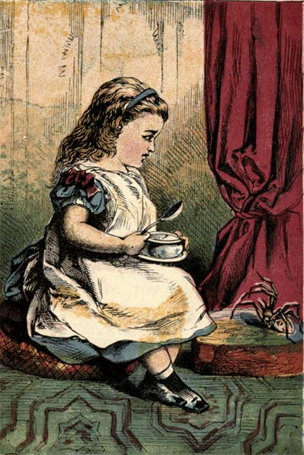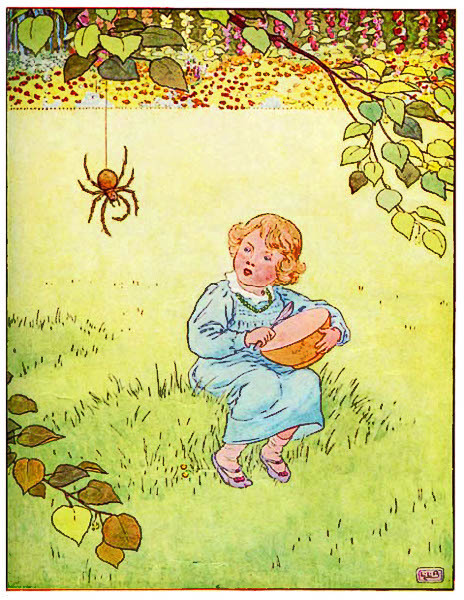 I am not usually scared of spiders and have been known to actually quickly pick up and dispose of a spider if need be, though I prefer to use a glass and bit of cardboard to “capture” and transport them outside.
I am not usually scared of spiders and have been known to actually quickly pick up and dispose of a spider if need be, though I prefer to use a glass and bit of cardboard to “capture” and transport them outside. The other day I was sitting – not on a tuffet – but in the littlest room in the house, when I looked up and there on the wall was a spider.
Now I wasn’t too worried as we had seen this spider up in the corners for a few days and it seemed to be keeping to itself, but for it to come “along’” and nearly “sit down beside” me was enough for me to decide it was time for it to be moved out into the big world yonder – of our front door.
The other day I was sitting – not on a tuffet – but in the littlest room in the house, when I looked up and there on the wall was a spider.
Now I wasn’t too worried as we had seen this spider up in the corners for a few days and it seemed to be keeping to itself, but for it to come “along’” and nearly “sit down beside” me was enough for me to decide it was time for it to be moved out into the big world yonder – of our front door.Now as you can see this was no little spider. At over three and a half centimeters in length it was not something I was going to pick up in my hand. So it may not have frightened me away but it certainly got removed so that it wouldn't distract me any more from the the needs of nature.
Arachnophobia is the fear of spiders. People with Arachnophobia tend to feel uneasy in any area they believe could harbour spiders or that has visible signs of their presence, such as webs. If arachnophobics see a spider, they may not enter the general vicinity until they have overcome the panic attack that is often associated with their phobia. Some people scream, cry, have trouble breathing, have excessive sweating or even heart trouble when they come in contact with an area near spiders or their webs. In some extreme cases, even a picture or a realistic drawing of a spider can also trigger fear.
Now I can say I definitely don't suffer from arachnophobia but I would assum that Miss Muffet probably did!
Little Miss Muffet
sat on a tuffet
Eating her curds and whey,
Along came a spider,
Who sat down beside her
And frightened Miss Muffet away.
Some of Mother Goose's rhymes have very old English words in them. Some people say a tuffet can be either a mound, an area of grass (from tuft of grass) a little grassy bump big enough to sit on or a low three-legged stool and others say it is.
 Whey is the watery part of milk that separates from the curds when making cheese. It is similar to what we now know as cottage cheese.
Whey is the watery part of milk that separates from the curds when making cheese. It is similar to what we now know as cottage cheese.
 Like many such rhymes, its origins are unclear. Little Miss Muffet was a small girl whose name was Patience Muffet. Her stepfather, Dr. Thomas Muffet (possibly Moffett or Moufet), (1553-1604) was an English physician and a famous entomologist who wrote the first scientific catalogue of British Insects The Silkwormes and their flies "lively described in verse". Whilst eating her breakfast of curds and whey Little Miss Muffet was frightened by one of his spiders and ran away! This particular Nursery Rhyme of Little Miss Muffet reputedly dates back to the late 16th century as indicated by the birth date of Dr Muffet!
Like many such rhymes, its origins are unclear. Little Miss Muffet was a small girl whose name was Patience Muffet. Her stepfather, Dr. Thomas Muffet (possibly Moffett or Moufet), (1553-1604) was an English physician and a famous entomologist who wrote the first scientific catalogue of British Insects The Silkwormes and their flies "lively described in verse". Whilst eating her breakfast of curds and whey Little Miss Muffet was frightened by one of his spiders and ran away! This particular Nursery Rhyme of Little Miss Muffet reputedly dates back to the late 16th century as indicated by the birth date of Dr Muffet!
Most literary scholars, who note that stories linking folk tales or songs to political events are often urban legends. Mother Goose scholars agree that "Little Miss Muffet" is not about the more unlikely story of the staunch Roman Catholic Mary, Queen of Scots. It was suggested that Mary, Queen of Scots (1542-1587), was the little Miss Muffet referred to in the rhyme and that the Scottish religious reformer John Knox (1505 or 1510 – details are sketchy-1572), was the spider who frightened her away. Mary Queen of Scots eventually fled from Scotland due to the hatred of the religious reformers. And is refuted to have said “I fear the prays of John Knox more than all the assembled armies of Europe” Mary Queen of Scots was eventually beheaded in 1572 when she was found guilty of involvement in plans to assonate her cousin Queen Elizabeth I.
Accreditation is deemed shaky by some. The rhyme first appeared in print in 1805, in a book titled Songs for the Nursery, whose 1812 edition read "Little Mary Ester sat upon a tester . . . ." Halliwell's 1842 collection read "Little Miss Mopsey sat in a shopsey . . "
 |
| Mary Queen of Scots |

No comments :
Post a Comment